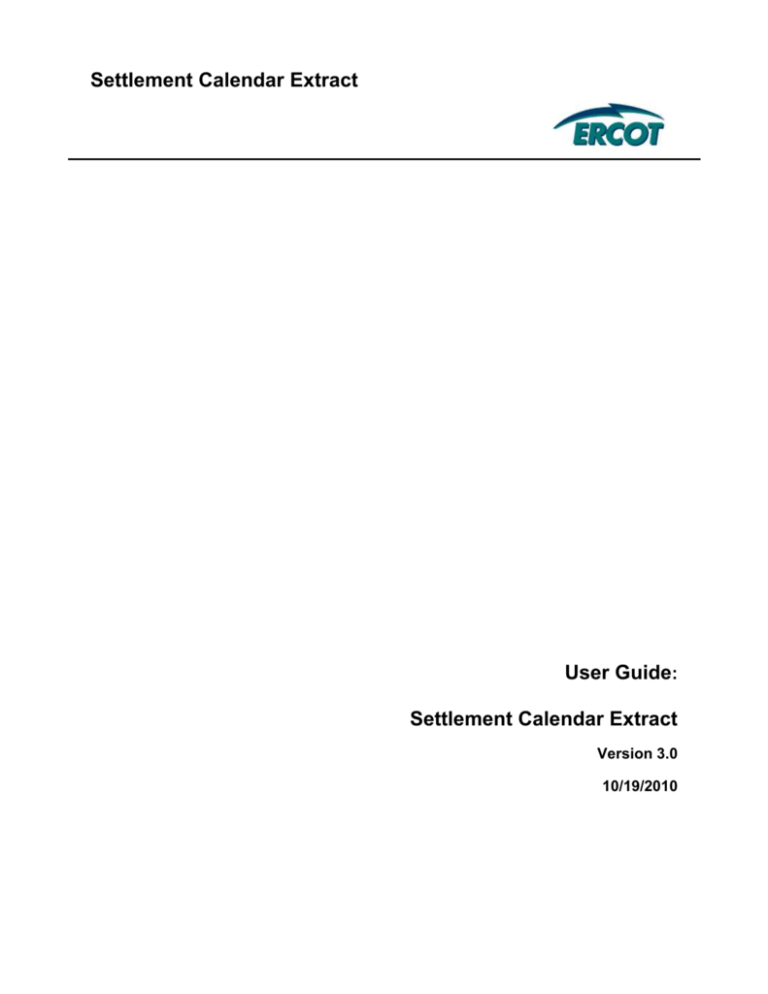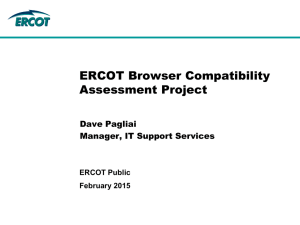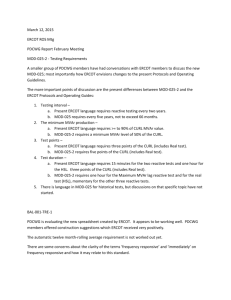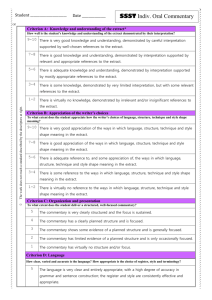
Settlement Calendar Extract
User Guide:
Settlement Calendar Extract
Version 3.0
10/19/2010
Settlement Calendar Extract
ERCOT Public
__________________________________________________________________________________________________________________________________________
Table of Contents
1. Overview .......................................................................................................................................... 1
1.1.
Background
1
1.2.
Document Purpose
1
1.3.
Applicable Documents, Standards, and Policies
1
1.3.1. Nodal Protocol References ................................................................................................. 1
1.3.2 Service Level Agreement Requirements ............................................................................ 1
2. Summary .......................................................................................................................................... 1
2.1.
Overview of Settlement Calendar Extract
1
2.1.1. General Extract Information ............................................................................................... 1
2.1.2. Extract Recipients............................................................................................................... 2
2.2.
About ERCOT Data Extracts
2
2.2.1. Data Definition Language and XML Schema Definition Files .......................................... 2
2.2.2. Creating the Database Structure ......................................................................................... 3
2.2.3. Applying Changes to the Database Structure ..................................................................... 3
2.2.4. Loading Scheduled Extract Data ........................................................................................ 4
2.2.5. Handling Exceptions .......................................................................................................... 5
3. Content ............................................................................................................................................. 5
3.1
Content Description
5
3.2
Timing
5
3.3
Security Requirements
6
4. Design .............................................................................................................................................. 6
4.1
Format of the Extract
6
4.2
DDL / XSD
6
5. Delivery............................................................................................................................................ 6
5.1
General Delivery Information ............................................................................................ 6
5.2
API Information ................................................................................................................. 6
5.3
Scheduling an extract
© 2007-2010 Electric Reliability Council of Texas, Inc. All rights reserved.
6
i
Settlement Calendar Extract
ERCOT Public
__________________________________________________________________________________________________________________________________________
1. Overview
1.1. Background
The Settlement Calendar Extract provides Market Participants with a Settlement Calendar to denote, for
each operating day, when a Settlement Statement is issued, a Settlement Invoice is issued, payments are
due, Settlements and Billing Disputes for each Statement must be submitted in order to be considered
timely.
1.2. Document Purpose
This document describes the data contained within the Settlement Calendar Extract, audience for which
the information is available, access and delivery information and an explanation on how the report is
designed.
The document is intended to provide a business understanding of the data contained and how this data
can be applied to the Market Participant. Any additional information regarding the Settlement Calendar
Extract will be communicated to the market from ERCOT on an as needed basis. Please ensure that
these communications are passed within your organization to the appropriate parties responsible for the
business and technical aspects of processing Settlement Calendar Extract data.
When translating the logic within this document to your own systems, please be aware that the examples
may need modifications in order to accommodate your unique environment. Thorough testing is strongly
advised.
1.3. Applicable Documents, Standards, and Policies
1.3.1.
Nodal Protocol References
The following Protocol(s) apply to the Settlement Calendar Extract:
o
1.3.2
NP 12.3 (c)
Service Level Agreement Requirements
The Settlement Extract Working Group (SEWG) which falls under the Commercial Operations
Subcommittee (COPS) is responsible for helping to maintain and manage the Data Extract and
Reports SLA. This report currently falls under the Extract and Reporting SLA. Please refer to
the SLA section of the ERCOT website for the most up to date service level information on this
report.
2. Summary
2.1. Overview of Settlement Calendar Extract
The Settlement Calendar Extract provides necessary data to help ensure that market systems and
products at ERCOT are in synch with Market Participant market systems and expectations for product
delivery/due dates as designed by protocols.
2.1.1.
General Extract Information
This data extract provides Participants with a Settlement Calendar for each operating day.
© 2007-2010 Electric Reliability Council of Texas, Inc. All rights reserved.
1
Settlement Calendar Extract
ERCOT Public
__________________________________________________________________________________________________________________________________________
2.1.2.
Extract Recipients
Recipients of this extract include ALL Market Participants as Settlement Calendar Extract is a
Public report.
2.2. About ERCOT Data Extracts
While data extracts are not intended to provide a single solution to resolve all Market Participant needs, they
provide Market Participants with the data sets used by ERCOT to manage and settle the energy market.
ERCOT data extracts provide a framework that allows Market Participants to retrieve ERCOT market data for
analysis. This framework has two key elements:
DDL/XSDs
Data Extract Distributions
Data Definition Language (DDL) / XML Schema Definition (XSD)
To enable Market Participants to load ERCOT data into their own environments, ERCOT structures the
data in the form of data definition language (DDL) and XML schema definitions. The DDL/XSD provides
metadata, including the data type of each field, a brief description of the data that is to be loaded into each
column and any table or character/precision constraints or alterations. The DDLs and XSDs are available
on both the MIS index page and public portlets and on ERCOT.com, under the ‘Market Data
Transparency’ page.
Data Extract Distributions
ERCOT utilizes both a standard comma-separated value file format (.CSV) and an Extensible Mark-Up
Language (.XML) for extract data delivery. This approach ensures portability across most platforms and
architectures. The .CSV and .XML files are packaged in zipped files, and are available to the market
through the Market Information System (MIS) website and/or API. Market Participants have the option of
choosing either CSV or XML files to receive when scheduling the extract using the Extract Subscriber
located on MIS.
2.2.1. Data Definition Language and XML Schema Definition Files
The data delivered to Market Participants comes from the ERCOT systems database data. There is
a specific methodology which should be followed for importing data. ERCOT makes available a set
of metadata data files that contain data definition language (DDL) in Oracle format and XML
schema definition in XML format to create relational tables and constraints (primary and foreign
keys). The DDL/XSD can store the data extract definitions made available to Market Participants
via the MIS. In addition, the DDL also contains database comments to define the expected use of
each table and field. While ERCOT provides DDL scripts in Oracle format, there are several CASE
tools on the market that can reverse-engineer this DDL file and create new DDL scripts for a broad
range of database products. A database administrator should also have the ability to alter the DDL
to represent the intended database structures for a particular environment.
The DDL and XSD scripts are posted by ERCOT to the MIS and ERCOT.com and can be executed
against an Oracle database instance. The same DDL script can be executed more than once
against a database without harming structures that are already in place. Error messages will occur
on DDL execution when the structure or constraint is already in place. These messages do not
harm the database structures. These messages would include: “table already exists”, “table cannot
have more than one primary key” and “foreign key already exists in table.” See the ‘Creating the
Database Structure’ section below for more details.
If a Market Participant is new to the extract process, they should begin by running the complete
DDL or XSD. In the event that a change occurs to the requirements of the extract, ERCOT will
© 2007-2010 Electric Reliability Council of Texas, Inc. All rights reserved.
2
Settlement Calendar Extract
ERCOT Public
__________________________________________________________________________________________________________________________________________
generate, distribute and post a new set of DDL and XSD scripts, reflecting the new table structure.
If a Market Participant has previously created the extract tables in their own database, they should
run the updated DDL or XSD to apply the appropriate updates. Upon execution of the appropriate
DDL/XSD file, the extract database schema will be updated to accommodate the extract data in its
format. Although running the complete DDL/XSD on your database will not harm your data
structures, failure to run any provided incremental DDL/XSD changes on existing databases could
leave the database without required data tables and/or fields. This could cause data loading errors
going forward. See ‘Applying Changes to the Database Structure’ for more information regarding
the DDL/XSD change process.
The column comments provided within the DDL are to aid the user with the business definitions of
field values. Please note that the DDL does not contain statements which define the physical
storage parameters of the individual tables. Storage values will vary greatly by Market Participant.
The DDL also does not contain performance-based indexes. If you have performance issues with
your queries, then we suggest that you consult with your DBA.
2.2.2. Creating the Database Structure
When a Market Participant is setting up a database for an extract for the first time, it is
important to determine if your company will benefit more from a single schema/database
containing all data retrieved from ERCOT with scheduled extracts or if it is best to generate
independent, private schemas/databases for each ERCOT extract.
If you decide to create a unified schema, then keep in mind that one table can be defined in
more than one DDL/XSD file. Therefore, running all DDL/XSD scripts in a single schema could
generate errors indicating previous existence of foreign keys, primary keys and tables.
ERCOT recommends the use of a separate schema or database instance for this extract in
order to minimize confusion.
ERCOT also recommends the creation of two database structures: a staging area and a work
area. The staging area should contain only table definitions (no primary or foreign keys) that
will be used for staging the data rows being imported. These staging tables would hold data
temporarily and will allow for better processing and error tracking. All staging tables MUST be
truncated to an empty state after each extract load or prior to the next extract load. The work
area will have the tables, primary keys and foreign keys as defined in the DDL/XSD.
This is a simplified example for the daily extract loading process using a staging area:
1. Download data extract Zip file from the ERCOT TML
2. Extract CSV/XML files from Zip file
3. Load all extracted files into staging area
4. For each staging table, iterate through each row:
4a. Insert row - if there is a primary key violation, then use INSERT/ELSE UPDATE logic
retaining the appropriate record with the greatest add time (i.e., ADDTIME, LSTIME or
TIMESTAMP) in your database
4b. Remove row from staging area
In order to implement this process, the Market Participant will need programmatic support.
There are several options for development and implementation: SQL*Loader, PL/SQL, PERL,
Visual Basic, etc. See ‘Loading Scheduled Extract Data’ for more information about loading
data into DDL structures.
2.2.3. Applying Changes to the Database Structure
The data extract files are based on a database model expressed by the DDL/XSD scripts.
Every time there is a change in the underlying data structures, a new DDL/XSD script will be
released by ERCOT. As mentioned previously, ERCOT produces a complete DDL/XSD and an
incremental DDL every time a change is necessary.
© 2007-2010 Electric Reliability Council of Texas, Inc. All rights reserved.
3
Settlement Calendar Extract
ERCOT Public
__________________________________________________________________________________________________________________________________________
Following is a list of possible changes to the database and courses of action. This is a general
guide, not an all-inclusive list.
New Table
Create new tables in your database based on your DDL/XSD (and staging area, if you
have one) and import the data from the extract. Transactional table data will begin
appearing on the day the new DDL is scheduled to be implemented. Dimensional data
tables (e.g., QSE) will receive a complete load of the records on the go-live date
relevant to the Market Participant. Subsequent data extracts will contain any new or
changed records in the ERCOT system for the new table.
Table Removed
Drop the table from your system. ERCOT will provide detailed instructions, as well as a
new DDL/XSD, for these types of database changes.
Column Removed
In Oracle, it is possible to issue an “alter table” command with a “drop column” action.
For other databases, perform the appropriate action to achieve the desired result (this
may include the creation of a temporary table followed by the re-creation of the table). If
the column is part of the primary key, there will be foreign keys on other tables affected
by the change. The constraints must be dropped before making the changes (on all
affected tables) and recreated afterwards.
Added Column
In Oracle, a column can be added by issuing an “alter table” command with an “add”
option. In most cases the column can be added at the appropriate time and with proper
adjustments, the load process will proceed seamlessly. If the new column has been
added to the primary key of a table, all child tables will be changed as well. Constraints
must be dropped before adding the column and recreated afterwards. If the column is to
be included in the primary key there may be special instructions on how to initialize the
values for the column (i.e. no nulls).
2.2.4. Loading Scheduled Extract Data
Once the ZIP file is retrieved from the Market Participant folder on the ERCOT MIS, it should be
expanded into a directory and inspected for completeness. Each individual CSV or XML inside the
ZIP file contains data for a single table. The table name and processing date are part of the file
name. For tables that are transactional in nature, the Market Participant DUNS number will also
appear in the name of the CSV/XML.
The file format is a standard comma-separated values file. It can be opened using Excel if there is
a desire to view the contents on an ad hoc basis. It is important to note that text fields are enclosed
in quotation marks (“). The tool used for importing the data (such as Oracle’s SQL*Loader) should
be set up to expect the quotation marks in order to load the data correctly. A comma inside a text
field is a valid value so it is necessary to delimit text fields in this manner.
ERCOT recommends using the date embedded in the name of the file for each table to determine
load order if you are processing more than one day of extracts at any given time.
ERCOT recommends truncating the tables before loading the full tables for the day. This is to
ensure simplicity in the loading process since not all records included in the daily extract will be
new.
© 2007-2010 Electric Reliability Council of Texas, Inc. All rights reserved.
4
Settlement Calendar Extract
ERCOT Public
__________________________________________________________________________________________________________________________________________
Example: PL/SQL procedure to load table from “staging” area to “work” area
Following is an example of a SQL*Loader process to load the QSE table. First, create a working
directory and place the CSV file in that directory. Create a SQL*Loader control file in that directory
and call it QSE.CTL. For example:
LOAD DATA
INTO TABLE RESOURCEID
FIELDS TERMINATED BY ',' OPTIONALLY ENCLOSED BY '"'
TRAILING NULLCOLS
(QSECODE
VARCHAR2(64),
QSENAME
VARCHAR2(64),
STARTTIME
DATE Not Null,
STOPTIME
DATE,
DUNSNUMBER VARCHAR2(64),
UIDACCOUNT NUMBER(10),
LS Time
DATE)
2.2.5. Handling Exceptions
Foreign Key Error
This means that a table’s row is being loaded before its parent record is loaded causing a foreign
key error. To solve this problem, it is necessary to load the CSV’s in the correct order. The
loading of the RID/REC DDLs do not add any Foreign Key constraints, so the error will not be
produced loading the extracts into these structures. This error would only be generated if
referential integrity is enforced through additional Foreign Key constraints
Duplicate Primary Key
If a circumstance occurs that causes a duplicate, the row with the greater PIT_START should be
retained, unless a history of all transactions is being kept within the database. The record with
the latest PIT_START will be the most recent version of the record. Anytime a duplicate row is
identified and there is no difference in the PIT_START or PIT_STOP columns, then one row
should be deleted, as these would be redundant.
3. Content
3.1
Content Description
Extract Data Tables
Settlement Calendar data is available to all Market Participants. There is one table included within the
extract:
SETTLEMENT_CALENDAR
Add times
Data record add times are triggered by insert and update commands in the ERCOT production systems.
All Data tables use the ADDTIME column, which include the following tables:
Table. Add Time Column
SETTLEMENT_CALENDAR.PostDate
3.2
Timing
ERCOT will post the Settlement Calendar Extract Data to the ERCOT Market Information System (MIS)
daily in the MIS Public section and on the ERCOT website with only the most current report being
displayed on MIS.
© 2007-2010 Electric Reliability Council of Texas, Inc. All rights reserved.
5
Settlement Calendar Extract
ERCOT Public
__________________________________________________________________________________________________________________________________________
3.3
Security Requirements
The Settlement Calendar Extract is a public classification of data available on the MIS and API. Any
Market Participant with digital certificate access can utilize the MIS Public area and are users can access
the ERCOT website to obtain the report.
4. Design
4.1
Format of the Extract
The Settlement Calendar Extract will be delivered to the MIS in the format of a “.zip” with a “csv” or “xml”
file included within. The name of the file as it appears in the Market Participant’s Report Explorer Folder
named “Settlement Calendar Extract” on the MIS will be:
ext. reportid.dunsnumber.yyyymmdd.hh24:mi:ss. SettlementCalendar_csv OR xml.zip
The naming convention of the transactional files stored within the .zip file is (X’s represent DUNs number
places padded with leading 0’s to 16 characters)XXXXXXXXXXXXXXXX-SettlementCalendar.csv OR .xml
4.2
DDL / XSD
The DDL / XSD associated with Settlement Calendar Extract are available on both the MIS index page
and public portlets and on ERCOT.com, under the ‘Market Data Transparency’ page. The most current
DDLs / XSDs for all reports and extracts will be available in these locations. The DDL name for this report
is Settlements Calendar DDL. The XSD name for this report is Settlements Calendar XSD.
5. Delivery
5.1
General Delivery Information
One zip file will be posted for each extract run.
5.2
API Information
To programmatically download the information from the API, the user needs to use the reports “report
type” ID in order to “Get report” or “Search” for the report on the API. The Settlement Calendar Extract,
report type ID = 11116.
5.3
Scheduling an extract
To schedule an extract, Market Participants must access the Extract Subscriber application available on
MIS using their digital certificate. For more details regarding the Extract Subscriber, refer to the Extract
Subscriber user guide posted on the ERCOT website at http://www.ercot.com/services/mdt/userguides/.
© 2007-2010 Electric Reliability Council of Texas, Inc. All rights reserved.
6







